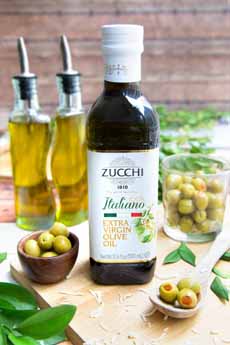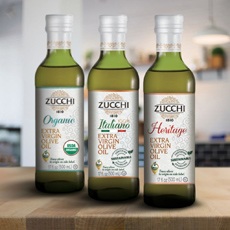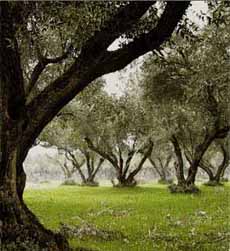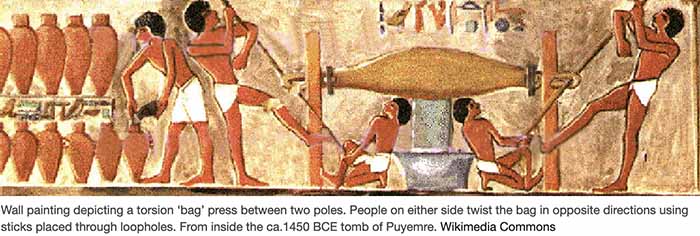TOP PICK OF THE WEEK: Zucchi Extra Virgin Olive Oil
 [1] Look for Zucchi olive oil in your supermarket (photo © Oleificio Zucchi).
*EVOO is an acronym for extra virgin olive oil. |
We’ve tasted a lot of extra virgin olive oil, both at industry events (100 California olive oils in one sitting!) and in a massive tasting at THE NIBBLE (90 olive oils), among smaller nibblings.
Occasionally, we have called out a few as Top Pick Of The Week, but it’s hard to do so: There are so many EVOOs* that deserve your attention. Zucchi 1810 olive oil is a brand available at better supermarkets and specialty food stores. At less than $10 a bottle, it tastes as good as olive oils which are twice the price. > The history of olive oil is below. > The different types of olives and olive oil: a photo glossary. Oleificio Zucchi was founded in 1810 near Lodi in northern Italy. It’s now in the hands of the seventh generation. By the 1990s, constant growth made it necessary to move the business to its current 86,000-square-foot facility in Cremona. The production capacity is now almost 400,000 gallons/day of packaged oil! While that’s a lot of olive oil, the company produces oils that taste as good as some oils that are produced in small, artisan facilities. Using state-of-the-art technology, Zucchi has created an “olive oil cellar,” Italy’s largest temperature-controlled storage facility, maintained at a constant 60°F and capable of storing some 5,300 tons of extra virgin olive oil. The goal is to deliver an excellent oil whose organoleptic properties—taste, aroma, appearance—remain constant over time. The company is proud of its sustainability and traceability: a sustainable supply chain founded on environmental sustainability, transparency at every step of production (traceability—you can trace your bottle with the QR code on the label), and fair wages for workers. You may notice single-cultivar olive oils: arbequina, cerignola, frantoia, and scores more. (There are more than 500 different cultivars in Italy alone, although some are better for eating than for pressing into oil.) While single-cultivar oils are usually the province of artisan growers, the majority of olive oils are a blend of several cultivars (varieties) each of which brings a unique flavor profile to the blend. In the blending room, finding the right balance between fruity and peppery, bold and delicate requires knowledge and skill. The objective is to find the best blend of cultivars (and origins, since olives planted in different regions can have different personalities), and the best percentages of each. The art of blending is the ability to create oils with specific personalities that appeal to different consumer tastes. It is a fascinating procedure, and we have been fortunate to try it at a Zucchi blending event (photo #2). Just think of how both Americans’ use of olive oil, and our culinary trends, have changed over the last 30 years, and you’ll see why producers continually seek optimal blends. There are an infinite number of blends, but here are the different flavor styles of olive oil with which to begin. Which blend is right for you? It’s only by tasting that you know if you’d rather dress your salad with an oil that’s buttery, fruity, or peppery; mild, robust, or intense. |
|
|
TRY ZUCCHI EXTRA VIRGIN OLIVE OILS Head down the olive oil aisle and you’re likely to find different blends of Zucchi EVOO: Heritage, Italiano, Organic, and Sweet & Fruity (“sweet” refers to the fruit flavors). There are also three flavored EVOOs: Chili Pepper, Garlic, and Pesto. All are delicious; we use all of them. You can find a 500ml/16.9-ounce bottle for $9.99. > Discover more at Zucchi.com. It’s easy for olive oil to go rancid if it isn’t stored properly, or if it’s too old. Here are the three things to remember. 1. To conserve any oil’s sensory and nutritional properties, seal the container tightly after each use. 2. Keep it away from light. In fact, like wine, the bottle should be green or other dark glass to filter out the light. 3. Store it below 68°F/20°. The ideal range is between 53°F/12°C and 46°F/18°C). This means: Find a cool spot in the kitchen, never next to the stove or oven. Even so, use up the olive oil as quickly as you can. While some olive cultivars age better than others, and we’ve successfully used oils that are two years old, ideally don’t buy more than you’ll use in 6 months or so. Also, look for a bottling date before you buy the bottle. Fresh is best. |
||
|
THE HISTORY OF OLIVE OIL
The olive tree is native to the Mediterranean basin; wild olives were collected by Neolithic peoples as early as the 8th millennium B.C.E. The wild trees are believed to have originated in Greece and were first domesticated in one of three places: Asia Minor, the Levant†, or in Mesopotamia (source). Olive tree cultivation reached Iberia (Spain) and Etruscan Etruria (western Italy) well before the 8th century B.C.E. It spread to southern Gaul (France) in the 7th century B.C.E. Archaeological evidence shows that olives were pressed into olive oil by 6000 B.C.E. It was used every day, multiple times a day. Besides as food, olive oil was used for religious rituals and medicines, as lamp fuel, in soap, and in hair and skin care applications. It was a necessity in the ancient world. Olive oil was common in ancient Greek and Roman cuisine. As the Roman Empire expanded, olive trees were planted throughout the Mediterranean basin during the reign of the Roman Empire. While the first trees were brought to the Iberian peninsula by the Phoenicians and the Greeks, olive cultivation in Hispania, as the Romans called it, was expanded considerably by them, as they also improved the techniques of oil production. Palates were picky even in ancient times. Olive oil from Hispania was highly regarded by the Romans. But the historian Pliny the Elder, writing in the 1st century C.E., expressed his preference for Italian olive oil: Italy had “excellent olive oil at reasonable prices…the best in the Mediterranean.” |
 [4] Ancient Etruscan olive oil press (photo courtesy Michele Castaldo).
|
|
|
According to the historian Pliny the Elder, Italy had “excellent olive oil at reasonable prices” by the 1st century C.E.—”the best in the Mediterranean”, he maintained.
> Extra Virgin Olive Oil: An Overview > Glossary Of Olive Oil Types & Terminology > How To Taste Olive Oil (And Have A Tasting Party!) > The Different Flavors Of Olive Oil > Why You Should Replace Butter With Olive Oil > Food Fun: An Olive Oil Martini > Beware Of Fake italian Olive Oil __________ †The Levant was a large area in southwest Asia: south of the Taurus Mountains, with the Mediterranean Sea as the western boundary, and the north Arabian Desert and Mesopotamia in the east. “Levant” is an English term that first appeared in 1497. It originally referred to the “Mediterranean lands east of Italy.” The historical area comprises modern-day Iraq, Israel, Jordan, Lebanon, Palestine, and Syria. Among other popular foods, Levantine cuisine gave birth to baklava, falafel, kebabs, mezze (including tabbouleh, hummus, and baba ghanoush), pita, and za’atar, among other dishes that are enjoyed in the U.S. and around the world. CHECK OUT WHAT’S HAPPENING ON OUR HOME PAGE, THENIBBLE.COM. |
||






